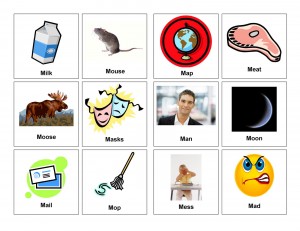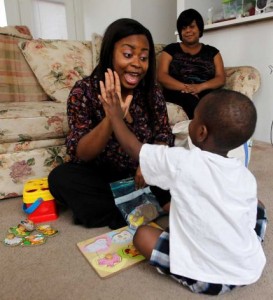How To Make M&m Mcflurry
How to Teach the "Thou" Sound

Image source: clearspeechtherapy.blogspot.com
Babies often begin their initial explorations with sounds with the "M" sound. If your baby's first discussion was "mama," he'southward not alone. Nearly children have command over this sound by the time they are 2 or 3, if non earlier. If you think that your child might be displaying difficulties with the "M" sound, consult a speech-linguistic communication pathologist (SLP) sooner rather than later. Although your child may non however be old enough to get to schoolhouse, you lot can still take advantage of free oral communication therapy with the Early on Intervention program.
The "M" Audio
The "M" audio is nasal. This means that air travels through the nose, rather than the mouth. Information technology is as well a bilabial audio, like the "P" sound, which means that it is formed by endmost the lips. Say "Mama." Now try to say information technology without endmost your lips for the second "m." It turns into an "N," doesn't it?
Tactile Sit-in
It is often helpful for a child to learn sounds by engaging several senses. He tin await at you for a visual demonstration and hear a verbal demonstration of the audio. He can too learn a sound with the sense of impact. To comport a tactile sit-in of the "G" sound, have your kid place his paw on your throat. Make the "Thousand" sound. Your kid volition exist able to experience your vibrating song cords. When you lot encourage him to make the sound himself, instruct him to identify his hand lightly on his ain throat to feel his vibrating vocal cords.

Image source: icanteachmychild.com
Visual Demonstration
During a time when your child is well-rested, sit with him. Take a handheld mirror handy. Engage him in a game of "monkey see, monkey do." Instruct him to copy your actions. Close your lips and betoken to them. Wait for him to do the same. Hold up the mirror and then that he can meet his closed lips.
Verbal Demonstration
While your child is looking at his closed lips in the mirror, verbally demonstrate the "Thousand" sound for him. Brand the "Mmmmm" sound with your airtight lips, every bit if you were praising a particularly tasty recipe. If your child appears to be losing his interest, make a funny face and laugh at yourself. Encourage him to brand the "Mmmm" sound, followed by his ain funny faces.
Verbally demonstrate whole words that brainstorm with "Grand." Start with simple words like "mama" and "moo" and progress to words like "melon," "magic," and "motor." Gradually, as your kid masters single words, begin to demonstrate them in brusque, simple sentences. For example, say, "Mama bought milk and melons." Brainstorm demonstrating words that do not begin with "Thou," but that contain the letter elsewhere. Say words similar "yummy," "tum," and "summer" and encourage your child to repeat them.

Epitome source: chron.com
Daily Activities
In addition to sitting down with your child regularly to exercise the "M" sound, comprise speech therapy into everyday activities. Children who might become bored with endless word repetitions might exist more than apt to practice the sound in a song. Search your local library for audio recordings of alphabet songs or create your ain silly song. For example, sing most a monkey at the zoo who wanted to swallow meatballs and marshmallows.
Inquire your child to help fix dinner. Make a game out of finding equally many ingredients that start with "M" as possible. When dinner is ready, praise it by proverb "Mmmmm! Yummy in my tummy!" On your adjacent family road trip, make a game out of pointing out all the objects with the letter "One thousand" that y'all and your kid encounter. Indicate out moving vans, mountains, mailboxes, and machines for road repairs. In addition to these simple activities, inquire your child's spoken language therapist about games that she uses in voice communication therapy so that you can exercise them at home as well.

Voice communication Therapy Techniques
Source: https://www.speechbuddy.com/blog/speech-therapy-techniques/how-to-teach-the-m-sound/


0 Response to "How To Make M&m Mcflurry"
Post a Comment